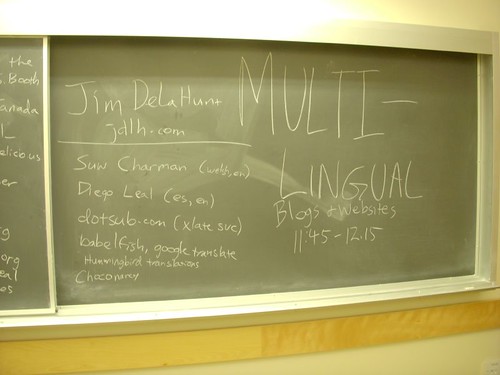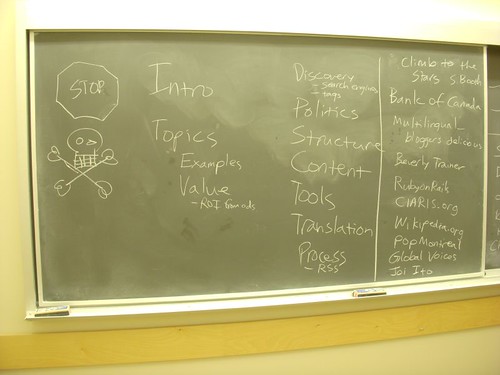I had a ball leading a session today at Northern Voice. I have lots of pictures, more reflections, etc. But that can wait to later. In the mean time (and in case there is no “later”) here is the link to the wiki page and the slides. northernvoice wiki / How I slowed down blogging and started drawing on walls
Author: Nancy White
northernvoice wiki / Multilingual blogs
northernvoice wiki / Multilingual blogs
I have some notes up – not edited yet, but if you are interested in multilingual blogging and websites, check it out. It would be great if you added examples, links. We have a tag going multilingual_bloggers on del.iciou.us
Live blogging caveat applies to live wiki-ing as well. I WILL make typos, miss things and make mistakes. And I won’t write down what I said.


For Nick Noakes from Northern Voice
Community Reality Check
This is too great not to reblog. Found via Jeremiah. Life Process Of A Community: Redux

Waving from NorthernVoice. Not sure how much I will blog and how much I will draw.
Forrester’s Online Community Best Practices
Last week I wrote briefly about the recent Forrester report on building online communities for marketing. Jeremiah Owyang followed up with me and gave me a copy of the report to read. House painting derailed my intent to read it last week and and post my thoughts, but a few quiet hours before Northern Voice in my room up here in Vancouver BC finally gives me the opportunity to reflect on the report.
First, it is a very nice compilation of solid, basic advice on building commercially oriented communities. There isn’t anything particularly unique about the content. It is common sense you can find by combing through what is offered on the net. As usual, the value is in the compilation. But here is where I have to confess. I have read VERY few analyst reports. I work in the non profit world where such products are rarely affordable. I think I had this fantasy idea of what they would be like. I expected some secret sauce. Maybe I know online communities so well that I forget that this stuff is NOT basic knowledge. So I have to wonder about the market for analysts reports. Clearly I am naive!
That said, here are the things that struck me as highs and lows of the report.
Highs:
- It is succinct. Something I am terrible at! 🙂
- It focuses on the community members and their needs – be in service to your community
- It offers sound advice for both resourcing a community and being clear on the goals and how they might be tracked. (I’d suggest linking to Beth Kanter’s great stuff on ROI. I need to find the links)
- Solid advice on community management (very happy to see this validated)
- A good attempt to frame community planning in terms of community activity needs rather than from a technology position.
- I was THRILLED to see the advice to make sure you don’t get your community data locked into a platform. This is really important and a lot of people miss this one.
Some of my critiques:
- As I mentioned in my previous blog post, the image about community growth does not give an accurate picture of community life cycle. Communities ebb and flow. Membership turns over. Communities do not grow out and out. It is more like a recursive spiral. Networks, however, can bring life into communities and nurture the emergence of new communities. They are far more scalable than communities, but harder to both measure and “manage.” Which leads me to my next point.
- The report doesn’t fully address or distinguish this very interesting intersection of communities and networks. There is one mention of “a group within an existing social networking site” but this is a huge sweet spot. I suspect most commercial endeavors really want to foster both a network and the communities that form within it. (I define communities as a bounded set of people interacting with each other – not just with content – around some shared purpose over time. So one time use does not a community member make! ) If I were exploring an “online community” strategy for my company, I would not do it without a network strategy as well. I could prattle on about this forever, but I can’t miss the party tonight…
- This raises the issue of identity, which wasn’t present in the report. Identity is a tough topic for an intro piece, but in the end, people define themselves by their identity as an individual (how they show up in a community) and as a member of a community (I am a member of the X community.) There is mention of profile tools, which help manifest identity, but not about how community hosts can nurture a sense of individual and group identity in a community. Identity is a core aspect of brand loyalty. So some attention to how identity shows up and can be nutured is a key strategy.
- From a design standpoint, I think this point is made, but I also think it could be stronger. You need to work with your developers to develop both the technical AND social architecture. Some tools for example, while they look like “conversation” tools, in practice they aren’t and thus don’t support a social conversational architecture, even if the vendor claims they do. There are some great developers who really understand social architecture and there are a bunch who think they do. This is a slippery slope/trap.
- Visual design is not mentioned. I used to dismiss this as secondary. Boy, was I wrong. Visual design that is appropriate to the target audience in critical. I learned this with http://www.shareyourstory.org. Visuals tie to identity, to navigation, and distinguish your community from the hundreds of others out there.
- How to work with “the competition.” Like I said, there are hundreds of other communities out there. Is your strategy to work with or fight against that dynamic? Do you make it easy for your members to move across their communities or do you want to be their central community? The latter is getting harder and harder to do. That’s why (and the report mentions this) thinking about working with a FaceBook strategy might make sense. Having multiple ways for your members to interact in your community that make it easy, while still maintaining enough distinct identity that they IDENTIFY with you.
All in all, it is very cool to be able to read and publicly critique the report. Jeremiah walks the talk of transparency and participating and listening to his network and communities. It is only a pity that the readers of the report may not see this practice in action. It could inform their community strategy as much, if not more, than reading the report. Because supporting online communities is not a formula. It is a practice. And practices have to be… well… practiced!

